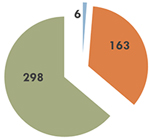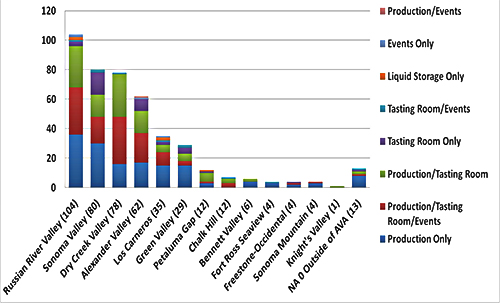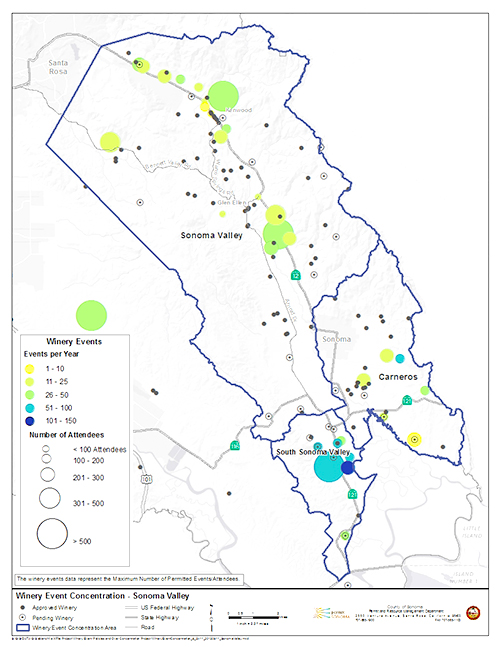- Accessory Units and Junior Units
- Agricultural Uses
- Agricultural Zoning Ordinance
- Cannabis Program
- County Code for Permit Sonoma
- Housing Urgency Ordinances
- Renewable Energy
- Septic Regulations
- Universal Design
- Water Efficient Landscape Ordinance
-
- Winery Events Calendar
- General Noise Standards
- Winery Use Permit Application Process
- Application Fees
- Required Site Specific Studies for Wineries
- Private Guest Accommodations
- Examples of Winery Project Descriptions and Conditions of Approval
- Areas of Local Concentration
- Draft Guidelines Dry Creek Valley
- Traffic Studies
- Use Permit Application Forms
- Document and Map Listings
- Z Accessory Dwelling Unit Exclusion Removal
- Back to Regulations and Initiatives
Presentation to the Sonoma Valley Stakeholders June 27, 2017

Objectives
- Balance winery related tourism against associated neighborhood impacts
- Protect Rural Character
Wine Industry
The Wine Industry is the largest sector of the Sonoma County economy.
- 59,770 acres of grapes
- $ 592 million crop value
- 54,000 jobs
- $1.25 billion wine-related tourism
- $13.4 billion total economic impact
 Sonoma County has 467 Wineries / Tasting Rooms
Sonoma County has 467 Wineries / Tasting Rooms
- 6 have Events Only
- 163 Winery Only
- 298 have a Public Tasting Room
Concentration Area Map - Sonoma Valley
Sonoma Valley - Highway 12 primary north/south Corridor Carneros Sout East portion 8th Streett East and Highway 121
South Sonoma Valley – Primarily south of Highway 121 to Highway 37 Over 100 wineries
Download a bigger map (PDF: 474 kB)
Type of Winery by American Viticultural Area (AVA)
Unincorporated Sonoma County Wineries
439 total as of June 2014
- 104 Russian River
- 80 Sonoma Valley
- 78 Dry Creek Valley
- 62 Alexander Valley Regions
- 35 Carneros
- 29 Green Valley

The other viticulture areas shown here have a dozen or fewer wineries including Chalk Hill, Freestone, Sonoma Mountain and Knights Valley
General Plan
Allow Promotional Events in Agricultural Areas:
- Secondary and incidental to agricultural production
- Limited in scale and intensity
- Avoid local concentrations
Board Resolution
- Clarify definition of events and allowable food service
- Require permits for industry-wide events
- Allow tasting rooms in Industrial Park zones
- Develop standards and siting criteria for areas of local concentration
Event Criteria
Activities involving any of the following criteria:
- Advertised to Consumers
- Food Service of Meals
- Music or Amplified Sound
- Fee for Event
- Outside of Tasting Room Hours
Types of Events
Business Trade Events
- Distributor Meetings
- Sales Partners
- Internal Staff
Private / Other Events
- Weddings
- Charitable/Political Fundraisers
- Corporate Retreats
- Concerts & Theater
Direct to Consumer
- Wine club events
- Winemaker dinners
- Release parties
Industry Wide
Key Issues
- Wine-Industry Business Needs
- Neighborhood Compatibility
- Impacts of Noise, Traffic, Water
- Commercialization of Agricultural Lands
- Preserving Rural Character/Local Concentrations
- Legal Non-conforming and Unpermitted Events
- Monitoring and Enforcement
Winery Event Working Group
- Event Coordination is needed
- Industry-wide events must follow best management practices
- Event areas need to meet General Plan Noise standards
- Parking management and queuing must be on site
- No stand alone tasting rooms – must have agricultural processing or production on-site
- No third-party rentals
- Allow food and wine pairing during tasting room hours
- Public access roads must meet safety standards
Noise Levels
| Event Activity | Noise Level @ 45-ft DBA | Distance to Attenuate |
|---|---|---|
| Amplified Music (wedding) | 75 | 1,580 feet |
| Amplified Music | 72 | 1,125 feet |
| Amplified Speech | 71 | 1,000 feet |
| Non-amplified Acoustics Music | 67 | 625 feet |
| Raised Conversations | 64 | 450 feet |
Local Concentration
General Plan Policy AR-6f
Local concentrations of agricultural support and visitor serving uses, even if related to agriculture, are detrimental to the primary use of the land for production and should be avoided.
Consider the following factors:
- Joint road access conflicts, site specific traffic impacts, and cumulative traffic impacts
- Groundwater impacts to aquifer and surrounding wells
- Detrimental to rural character
General Plan Policies
 What do we mean by rural character?
What do we mean by rural character?
Most people describe rural character as Low density development, open agrarian landscape, quiet, with low traffic volumes.
There are many factors and tools that can be used to maintain rural character. Zoning Code standards is one tool that can address cumulative impacts: operating standards .
Design review addresses architecture, building materials, site layout, lighting and landscaping – to assure compatible with rural character.
Use Permit conditions of approval address site specific & operational impacts .
Industry practices How does the winery address operations and site management – for example how well are industry wide events managed in terms of traffic.
Monitoring & Enforcement County Monitoring and Enforcement of winery COA to address Use Permit compliance issues.
Policy Options
- Minimum Site Area
- Setbacks
- Tasting Room Criteria
- Visitor Hours
- Separation Criteria
- Food Service
- Promotional Activities
- Access and Parking
- Monitoring and Enforcement

 Translate
Translate